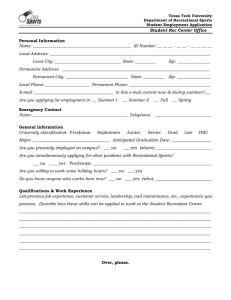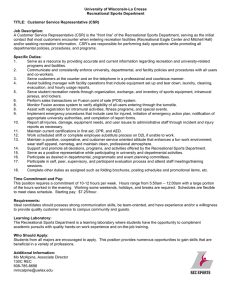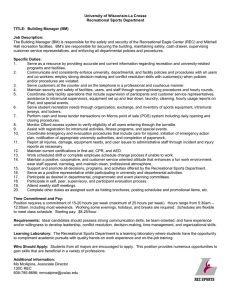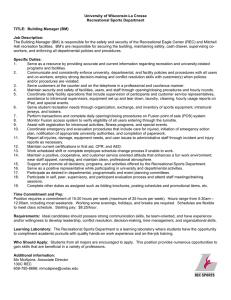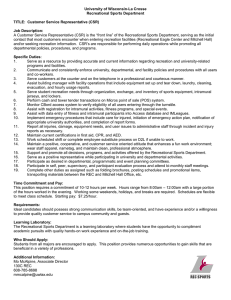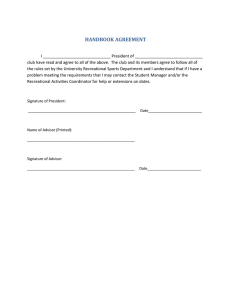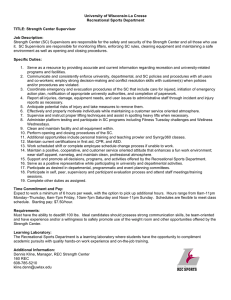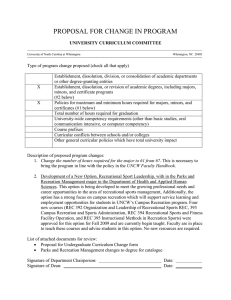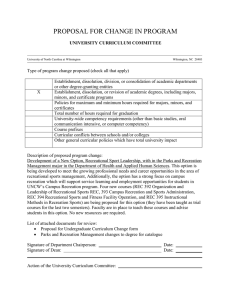Document 13136232
advertisement
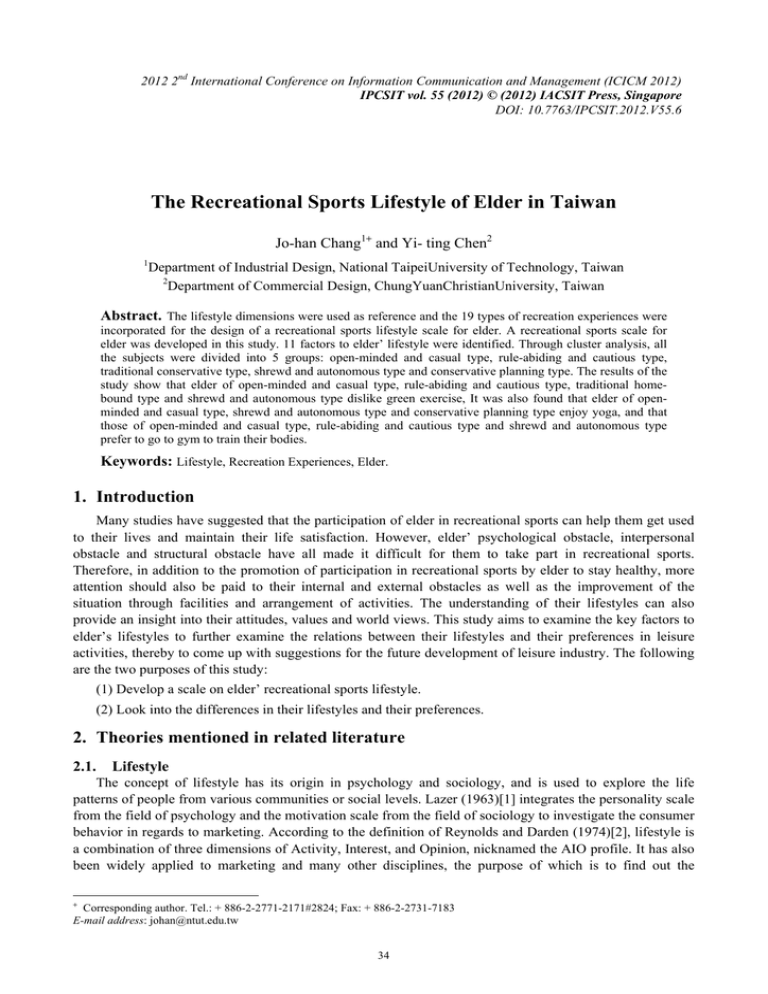
2012 2nd International Conference on Information Communication and Management (ICICM 2012) IPCSIT vol. 55 (2012) © (2012) IACSIT Press, Singapore DOI: 10.7763/IPCSIT.2012.V55.6 The Recreational Sports Lifestyle of Elder in Taiwan Jo-han Chang1+ and Yi- ting Chen2 1 Department of Industrial Design, National TaipeiUniversity of Technology, Taiwan 2 Department of Commercial Design, ChungYuanChristianUniversity, Taiwan Abstract. The lifestyle dimensions were used as reference and the 19 types of recreation experiences were incorporated for the design of a recreational sports lifestyle scale for elder. A recreational sports scale for elder was developed in this study. 11 factors to elder’ lifestyle were identified. Through cluster analysis, all the subjects were divided into 5 groups: open-minded and casual type, rule-abiding and cautious type, traditional conservative type, shrewd and autonomous type and conservative planning type. The results of the study show that elder of open-minded and casual type, rule-abiding and cautious type, traditional homebound type and shrewd and autonomous type dislike green exercise, It was also found that elder of openminded and casual type, shrewd and autonomous type and conservative planning type enjoy yoga, and that those of open-minded and casual type, rule-abiding and cautious type and shrewd and autonomous type prefer to go to gym to train their bodies. Keywords: Lifestyle, Recreation Experiences, Elder. 1. Introduction Many studies have suggested that the participation of elder in recreational sports can help them get used to their lives and maintain their life satisfaction. However, elder’ psychological obstacle, interpersonal obstacle and structural obstacle have all made it difficult for them to take part in recreational sports. Therefore, in addition to the promotion of participation in recreational sports by elder to stay healthy, more attention should also be paid to their internal and external obstacles as well as the improvement of the situation through facilities and arrangement of activities. The understanding of their lifestyles can also provide an insight into their attitudes, values and world views. This study aims to examine the key factors to elder’s lifestyles to further examine the relations between their lifestyles and their preferences in leisure activities, thereby to come up with suggestions for the future development of leisure industry. The following are the two purposes of this study: (1) Develop a scale on elder’ recreational sports lifestyle. (2) Look into the differences in their lifestyles and their preferences. 2. Theories mentioned in related literature 2.1. Lifestyle The concept of lifestyle has its origin in psychology and sociology, and is used to explore the life patterns of people from various communities or social levels. Lazer (1963)[1] integrates the personality scale from the field of psychology and the motivation scale from the field of sociology to investigate the consumer behavior in regards to marketing. According to the definition of Reynolds and Darden (1974)[2], lifestyle is a combination of three dimensions of Activity, Interest, and Opinion, nicknamed the AIO profile. It has also been widely applied to marketing and many other disciplines, the purpose of which is to find out the + Corresponding author. Tel.: + 886-2-2771-2171#2824; Fax: + 886-2-2731-7183 E-mail address: johan@ntut.edu.tw 34 common features among people of the same community to understand them and further predict their future behaviors (Lin, 2009) [3]. The lifestyle concept put forth by Plummer (1974) [4], which contains three dimensions – Activities, Interest and Opinion (AIO) - is the one that is most often adopted by academics nowadays. In this study, AIO lifestyle was used as reference standards for the design of a questionnaire to classify the lifestyles of elder. 2.2. Recreation experience Recreation was withdrawn from its traditional definition of activity by Drive &Toucher (1970) [5], who argued recreation is a type of human experience that is based on intrinsically rewarding voluntary engagement during non-obligated time. Unger andKernan(1983) [6] suggested that the psychological experience tourists obtained through participation in recreational activities can be divided into six types: sense of psychological content, sense of freedom, sense of dedication, sense of excitement, sense of improvement, sense of a spur of the moment. According to the influence of society, psychology and environment on tourists, Chen (1988) [7] considered that major experiences obtained include: escape from realistic pressure, contact with great nature, appropriate exercise, general studies, escape from personal and social pressures, learning to get along with others, learning to become more independent, self-fulfillment, family reunion, adventure, sense of security, cultivation of leadership and making new friends. Mantredo et al. (1996) [8] proposed that the experiences recreational activity participators wish to obtain be divided into 19 types to cover a wider scope and fully explain participators’ expectations for recreational activities. 3. Research method 3.1. A recreational sports lifestyle scale for elder To gain a better understanding of recreational sports lifestyle, a recreational sports lifestyle scale for elder was designed based on AIO dimensions, and by the incorporation of the 19 recreational experience types proposed by Mantredo et al. (1996) [8]. 3.2. An investigation into elder’ recreational lifestyles and their preferences An attempt was made to understand elder’s views on the physical environment and psychological factors to their lives and analyse their life patterns and their views toward surrounding environments. 3.2.1 The design of the questionnaire (1) Basic information on subjects: age, sex, occupation, educational level, residence and other demographical variables. (2) The research of elder’ lifestyle: The AIO scale was adopted to determine the dimension of questions. The 19 recreational experience types were incorporated to develop variable-related question items for the questionnaire. The following are variables used in this study. Activities (hobby, socialization, recreation, community, sports.), Interest (family, fashion, food, media.), Opinion (self, society, politics, education, product, future.) (3) Understand the subjects’ preferences in their recreational sports: do they go to gym to work out; do they listen to music when exercise; what do they prefer, static or dynamic sports; do they play digital games, and other question items. 3.2.2 Questionnaire survey: The survey was conducted among people aged over 50 between February and March 2011, in which a total of 45 valid responses were received. 3.2.3 Statistic analysis: descriptive statistical analysis, factor analysis, cluster analysis and ANOVA. 4. Conclusion and discussion 4.1. The recreational sports lifestyle scale for elder Table 1 is the recreational sports lifestyle scale developed in this study, which covers various types of recreation experiences and AIO dimensions. 35 Table 1 the recreational sports lifestyle scale for elder Recreation experience type Physical fitness Meet new people Nostalgia Share similar values Risk reduction Independence Risk taking Risk taking Physical rest Enjoy nature Nostalgia Outdoor learning Independence Escape physical stressors Creativity Share similar values Family relations Achievement/Stimulation Agreeable temperatures Teach/lead others Introspection Teach/lead others Be with considerate people Reduce tension Independence Family relations Risk reduction Independence Risk taking Creativity 4.2. Lifestyle No Lifestyle description sports socialization product 1 2 community product self product product 4 5 6 7 food media socialization self self politics society recreation society society society self product future 10 11 12 13 14 15 16 17 18 19 20 21 22 I exercise very often to stay healthy. I like to interact with people. For the same kind of products, I would trust established brands more and don’t want to give new brands a try. I take part in the activities arranged by the community for elder. I use assistance tools when exercise. I am a person who pays much attention to life quality. I know very well how to manage my assets. I am willing to try new gaming products, especially those designed for people of our age, as a recreational activity. I prefer playing chess and other static recreational activities to dynamic ones like mountain climbing. I care about my health very much. I am very interested in Chinese culture. I eat out and meet with people very often. I place great importance on the distribution of time between work and recreation. I don’t want to change my existing lifestyle. I discuss current social events with my friends. I read newspapers and magazines to understand the current situation of the society. I engage in activities together with my children (or grandchildren) very often. I agree that it is never too old to learn. I don’t have work pressure. I feel that I am physically and mentally young. I go to hospital for medical checkups periodically. I believe that the quality of a product is more important than its price. 23 I agree that people should have children so that their children can take care them. future self family hobby fashion education hobby 24 25 26 27 28 29 30 I would feel that I am abandoned if I am sent to a nursing home. I am able to take care of myself. I enjoy getting together with my family. I enjoy engaging in simple leisure activities at home. I know how to use a computer to send and receive e-mails, and surf on the Internet. I am not afraid of learning new things. I am interested in digital products. recreation 3 8 9 The different lifestyles and recreational sports preferences among elder 4.2.1 The analysis of elder’ lifestyle (1) Subjects’ basic information The ages of the subjects ranged between 50 and 80, with an average age of 63.28. 23 of the subjects were males, and 22 females. In terms of educational level, 11% of them were elementary school graduates; 17.8% junior high school graduates; 31.1% senior high school graduates and 40% with a college degree or above. 62.2% of them lived together with their spouses. 51.1% of them had to work to make a living; 31.1% lived on pensions; 15.6% were supported by their children, and 2.2% lived on old-age annuity payments. (2) The factors to elder’ lifestyle A principal component analysis was conducted to extract the key components of elder’s lifestyle. Statistic results showed that there were 11 factors whose eigenvalues were larger than 1. The graph of a steep slope suggests that the slope would become level after factor 11. Accordingly, the study was conducted using those 11 factors. Below are the denomination and analysis of those 11 factors: A. Interactive exchange: Centering on interaction with family members, Web surfing and sending and receiving e-mails, and not being afraid of learning new things. It is named Interactive exchange. B. Self-care: This factor features taking care of one’s body, being able to take care oneself, participation in community activities, etc. It is named Self-care. C. A peaceful and stable life: This factor is related to enjoying interaction with others, not wanting to change status quo, without work pressure, considering being sent to a nursing home as being abandoned, etc. It is named a peaceful and stable life. D. Being eager to learn and try new things: This factor has to do with the belief of “it is never too old to learn”, enjoy trying new games, being not afraid of learning new things and so on. It is named being eager to learn and try new things. 36 E. Static leisure: This factor focuses on the participation in simpleactivities. It is named static leisure. F. Pragmatism and aggressiveness: This factor is related to the habit of regular exercise, the understanding of social situation, paying attention to product quality, interest in digital products and so forth. G. Rule-abiding and friendliness: This factor is associated with using assistance tools in exercise, enjoying playing with grandchildren, the feeling of being physically and mentally young. H. Caring actions: This factor has to do with regular engagement in social activities, discussing social issues with friends, going to hospital for medical checkups periodically, etc. It is named caring actions. I. Being shrewd and fastidious: This factor is related to paying attention to the quality of life, knowing how to manage one’s wealth and participation in simple leisure activities at home. J. Being dependent and conservative: This factor has to do with the belief of “people should have children so that their children can take care of them when they are old”. K. Being precautious: This factor is related to the emphasis on time distribution between work and recreation. It is named being precautious. (3) The classification of elder’ lifestyles A cluster analysis was conducted among the 45 subjects based on the values of lifestyle factor analysis. Statistic software SPSS 12.0 was used for the analysis. The tree analysis shows the subjects can be divided into 5 groups based on the weight of each factor and be named accordingly. (Table 2) Table 2 the analysis of factors to the lifestyle of each group Interactive exchange Self-care A peaceful and stable life Being eager to learn and try new things Static leisure Pragmatism and aggressiveness Rule-abiding and friendliness Caring actions Being shrewd and fastidious Being dependent and conservative Being precautious Group 1 0.5957971 0.2149405 0.3689266 -0.0298961 0.3058818 -0.3907919 -0.5541393 -0.4445011 -0.5329984 -0.3049241 -0.1518013 Group 2 0.0927747 0.2022138 0.0625262 0.4120446 0.0693671 0.1786052 0.8539535 0.2737314 -0.0406875 0.0592384 1.1744503 Group 3 -0.6206228 -0.1667609 -0.2483606 -0.1799642 -0.4969025 -0.0231944 -0.0873199 0.382902 -0.1208729 0.516333 -0.4471765 Group 4 -0.0117532 -0.1877047 -0.0992673 -0.604581 0.7997646 0.2329105 0.3599371 0.4337911 1.3677872 -1.8526997 -0.7543901 Group 5 0.6519344 -0.6986859 -0.5252346 0.782978 0.0406239 1.3668556 -0.6891771 -2.410198 1.899336 1.2605503 0.2006491 A. Group 1: The weight of interaction factor is higher, implying that subjects in this group tend to be more open-minded and casual. Accordingly, the group is named open-minded and casual type. B. Group 2: In this group, the weight of precaution factor is heavier; as a result the group is named ruleabiding and precautious type. C. Group 3: In this group, the factor of being dependent and conservative weighs heavier. Hence, it is named traditional home-bound type. D. Group 4: The factor of being shrewd and fastidious weighs the heaviest followed by the factor of being dependent and conservative. Accordingly the group is named shrewd and autonomous type. E. Group 5: In this group, the factor of being shrewd and fastidious and the factor of being dependent and conservative weigh the same. As a result, the group is named conservative planning type. 4.2.2 Elder’ different lifestyles and recreational sports preferences In this phase, ANOVA was conducted to analyse the preference difference in recreational sports among different groups. The contents of questionnaires includes:Taichichuan, ballroom dancing, listen to music, go to gym to train one’s body, green exercise, swimming, Karaoke and enjoy the happy atmosphere, slowtempo exercise, in somebody’s company, Yoga, feel that riding a bicycle is a strenuous exercise, willing to pay to play recreational games, enjoy sipping tea alone at home, enjoy playing games together with children, have once bought digital game products for the sake of exercise. Statistic results showed that there exist obvious differences (P<0.01) in various recreational sports between the above 5 groups. 5. Conclusion and discussion In this study, the lifestyle dimensions presented by Plummer(1974)[4] were used as reference and the 19 types of recreation experiences put forward by Mantredo et al. (1996)[8] were incorporated for the design of a recreational sports lifestyle scale for elder. 37 A recreational sports scale for elder was developed. The scale contains 30 questions. Through statistical analyses, 11 factors to elder’ lifestyle were identified: interactive exchange, self-care, peaceful and stable life, being eager to learn and fond of trying new things, static leisure, pragmatism and aggressiveness, being ruleabiding and friendly, being shrewd and fastidious, being dependent and conservative, being precautious and sticking to principles. Through cluster analysis, all the subjects were divided into 5 groups: open-minded and casual type, rule-abiding and cautious type, traditional conservative type, shrewd and autonomous type and conservative planning type. The results of the study show that elder of open-minded and casual type; rule-abiding and cautious type, traditional home-bound type and shrewd and autonomous type dislike green exercise, suggesting that most elder nowadays lack motivation and interest in the contact with the great nature, which is not good to their health. Therefore, it is suggested that elder’s needs be better understood to arrange more leisure activities to provide them with opportunities to embrace the great nature. It was also found that elder of open-minded and casual type, shrewd and autonomous type and conservative planning type enjoy yoga, and that those of openminded and casual type, rule-abiding and cautious type and shrewd and autonomous type prefer to go to gym to train their bodies, indicating that more and more elder can now accept new recreational sports. Additionally, this study also found that elder doesn’t like to listen to music when they are engaging in recreational sports. In addition, experiments were conducted to verify that the use of the 19 recreation experience types as reference for the design of question items was conducive to the development of the lifestyle questionnaire. It is suggested that in the future more evaluations should be conducted on the feasibility of this method. 6. Acknowledgement Special thanks to National Science Council (99-2221-E-033-045-) for its support for this study. 7. Reference [1] W. Lazer. Life style concept and marketing. In: Greyser S, editor. Toward scientific marketing. Chicago: AMA; 1963, pp.58-72. [2] F. D., Reynolds. W. R., Darden. Constructing life style and psychographics. In:Wells WD, editor. Life style and psychographics. Chicago: AMA; 1974, pp.71-96. [3] I. J.,Lin.A Study of the Relations among Elderly People’s Living Styles,Involving Degree in the Health Residence,and Inclination of Moving into the Housing at Nantou Area. 2009, Nan Kai University of Technology, unpublished. [4] J. T., Plummer. The concept and application of life style segmentation. Journal of Marketing.1974, 38, pp.34-37. [5] B. L.,Driver, and R. C., Toucher. Toward a behavioral interpretation of recreation of planning. Element of Outdoor Recreation Planning, 1970, pp.9-31. [6] L. S.,Unger and J. B., Kernan. On the meaning of leisure: an investigation of some determinant of the subjective experience. Journal of Consumer Research 9. 1983, pp.381-392. [7] S. Y., Chen. Relationship between crowding and outdoor recreation experience,Taipei:Da-Li publish。1988. [8] Manfredo. B. L., Driver, and M. A., Tarrant. Measuring leisure motivation: A meta-analysis of the Recreation Experience Preference Scales. Journal of Leisure Research. 1996, 28 (3): 188-213. Born place: Taiwan Born year: 1977 Education background: National Cheng KungUniversity, Department of Industrial Design Degrees: Doctor ofIndustrial Design Working experience: Assistant Professor,Departmentof Commercial Design, Chung Yuan Christian University; Assistant Professor,Department of Industrial Design, National Taipei University of Technology Born place: Taiwan Born year: 1987 Education background: Departmentof Commercial Design, Chung Yuan Christian University 38
